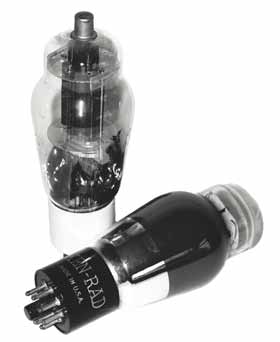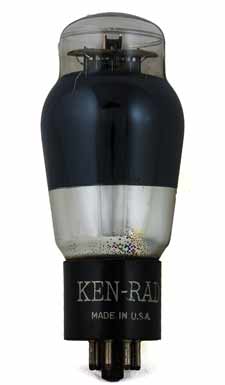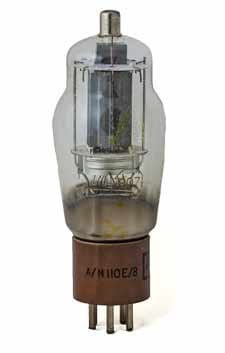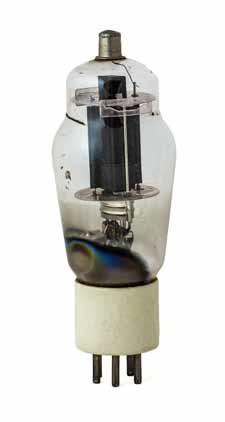6L6 Tube / Valve: 6L6G & 807
The 6L6 valve or tube represented a milestone in vacuum tube technology along with its sibling the 807 used in many radio transmitters.
History of the Valve / Tube Includes:
History overview
Early discoveries
Fleming's oscillation valve
de Forest's Audion
Development of the basic idea
R-type valve
6L6 valve
EF50 valve
The 6L6 vacuum tube or thermionic valve was one of the most iconic valves ever produced.
The 6L6 first appeared before the Second World War, and was widely used in many applications, especially in audio amplifier, finding particular favour in guitar amplifiers.
A development of the 6L6 was the 807 - a valve that took the basic 6L6 design, but used a top cap connection for the anode to enable it to be used in RF power applications.
6L6 history & introduction
The 6L6 valve design was undertaken in the mid-1930s. At this time Phillips had introduced its pentode valves and patented the idea. As the performance of triodes was far exceeded by that of tetrode and pentode valves, RCA developed and introduced the 6L6. The 6L6 was a beam tetrode and by adopting this format, it enabled them to circumvent the pentode concept.

6L6 & 807 Valves / Tubes
Up until the early 1930s all valves that were manufactured were triodes, i.e. they had a cathode, grid and anode. It was discovered that additional grids could be added to significantly enhance the performance of the basic triode and therefore valve manufacturing companies sought to offer the best performance by introducing valve designs with additional grids.
The disadvantage of the tetrode was that it used an additional grid with a relatively high potential on it to attract electrons away from the cathode area towards the anode. The downside of this was that the electrons gained sufficient energy that they often bounced off the anode and this gave rise to a negative resistance kink in the characteristic and this lead to instability in the circuit. This effect was known as secondary emission.
The 6L6 valve incorporated a number of new elements into the design:
- Critical distance: One of the concepts introduced into the 6L6 valve was that of the critical distance. A British engineer named J. Owen Harries is believed to have discovered that there was a critical distance between the anode and screen-grid in a valve. At this distance the efficiency of a power tetrode was maximised and the secondary emission from the anode was also reduced.
- Beam tetrode: The other main concept used within the 6L6 valve was that of the beam tetrode technique. In this, the concept behind, what was often termed the Harries valve, was further refined by EMI engineers Cabot Bull and Sidney Rodda. They used a pair of beam plates, connected to the cathode, which directed the electron streams into two narrow areas on the anode. This also acted like a suppressor grid to redirect some secondary electrons back to the anode reducing secondary emission and eliminating the kink in the tetrode characteristic curve. The Marconi Osram Valve Company, MOV marketed valves using this technology under the family designator, KT indicating the term 'kinkless tetrode.'

6L6 beam tetrode valve
The launch of the 6L6 is believed to be the first commercial production beam tetrode when it was launched in 1936. Although MOV had made a pre-production batch of their KT40 at least a year earlier it had not been a success and full production was not started and the design was abandoned. Apparently the company said it had been too difficult to assemble.
The 6L6 valve rapidly accelerated the electrons and it used very short electron paths to provide its high level of performance. However it still possessed a small kink in its characteristic and this mean that it did not provide the highest audio fidelity at high power levels.
Once the concept of the beam tetrode had been provide to work within a production environment by the 6L6, MOV re-engineered their designs to produce the KT66. This was very similar to the 6L6 valve but had a larger cathode and shorter and fatter anode. In addition to this, electrons were not accelerated as quickly and the paths were longer. This resulted in there being almost no kink in the curve. Accordingly the KT66 was the preferred choice for audio enthusiasts.
6L6 variants
The original 6L6 valve was contained within a black metal tube or casing. Later the 6L6G had an all glass envelope - this improved the radiation cooling of the anode.
Other versions of the 6L6 valve included the 6L6G, 6L6GA, 6L6GB, and the final version which was the 6L6GC. All these had glass envelopes.
807 beam tetrode valve developed
The 6L6 was particularly liked for audio applications, but it was not suitable for high power RF. By bringing the anode out through a top cap in the glass envelope. This overcame the issue of the 6L6 where high transient voltages on the anode when operating in class C could cause a flashover between pins 2 and 3 on the octal base.

An 807 - note top cap for anode connection
The 807 beam tetrode was used in many medium power transmitters. It was widely used in the Second World War. The British Army No 19 Set used one 807 valve in the final RF power amplifier stage, and the add on linear power amplifier used two 807s.

ATS25 - military version of 807
6L6 specifications & parameters
| 6L6 Characteristics & Parameters | |
| Parameter | Specification |
| Heater voltage Vh | 6.3V |
| Heater current Ah | 900mA |
| Max anode voltage Va | 350V (500V for 6L6GC) |
| Anode dissipation | 30W |
| Screen voltage, Vs | 250V |
| Anode resistance, ra | 33kΩ |
| Mutual conductance, gm; | 5.2 |
| 6L6 Valve Base Connections | |
| Pin Number | Connection |
| 1 | Not connected |
| 2 | Heater, h |
| 3 | Anode, a |
| 4 | Screen grid, g2 |
| 5 | Control grid, g1 |
| 6 | Not connected |
| 7 | Heater, h |
| 8 | Cathode, k & beam forming plates |
NB: the 6L6 uses an octal valve holder / base.
 Written by Ian Poole .
Written by Ian Poole .
Experienced electronics engineer and author.
More History:
Radio history timeline
History of the radio
Ham radio history
Coherer
Crystal radio
Magnetic detector
Spark transmitter
Morse telegraph
Valve / tube history
PN junction diode invention
Transistor
Integrated circuit
Quartz crystals
Classic radios
Mobile telecoms history
Vintage mobile phones
Return to History menu . . .




